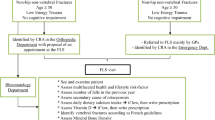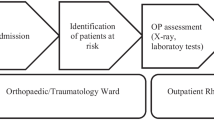Abstract
Summary
Osteoporosis is a metabolic disorder that results in increased bone fragility and risk of fractures. Hip fracture is the most important fragility fracture. Fracture Liaison Service (FLS) is a secondary prevention model which identifies patients at risk for fragility fractures. The introduction of an intensive FLS model could decrease 1-year-mortality of hip fracture patients.
Introduction
Hip fractures are a clinical manifestation of osteoporosis, and these patients are at risk of premature death and suffering subsequent fractures. FLS is an approach for secondary facture prevention by identifying patients with fragility fractures and initiating the appropriate treatment. Our objective is to analyze the effect of the FLS model over the first-year mortality rates following a hip fracture.
Methods
We conducted a prospective cohort study on patients over 60 years of age who suffered a hip fracture during two consecutive years, before and after the implementation of the FLS in our center (i.e., between January 2016 and December 2017). Patients’ information was withdrawn from our local computerized database. Patients were followed for 1 year after the hip fracture. Mortality and re-fracture rates were compared between the two groups using a multivariate Cox proportional hazard model.
Results
A total of 724 individuals were included in this study (i.e., 357 before FLS implementation and 367 after FLS implementation). Anti-osteoporotic drugs were more frequently prescribed after FLS implementation [275 (74.9%) vs 44 (12.3%); p < 0.01]. A total of 74 (20.2%) patients after FLS implementation and 92 (25.8%) individuals before FLS implementation (p = 0.07) died during the follow-up period. A second fracture occurred in 17 (4.6%) patients after FLS implementation and 13 (3.6%) individuals before FLS implementation (p = 0.50). Patients who were treated with anti-osteoporotic drugs after the implementation of the FLS protocol had a lower 1-year mortality compared with patients managed before the implementation of the FLS protocol (treated or not treated with anti-osteoporotic drugs) [adjusted hazard ratio (HR) 0.66; 95% confidence interval (CI) 0.47–0.94; p < 0.05].
Conclusions
We did not observe significant 1-year-mortality differences following a hip fracture between patients treated before the implementation of an FLS protocol and patients treated after its implementation. The application of the FLS did not affect the risk of suffering a second osteoporotic fracture. However, patients treated with anti-osteoporotic drugs in an FLS context had a lower mortality rate compared with patients managed before the implementation of the FLS.
Level of clinical evidence
2


Similar content being viewed by others
References
Hernlund E, Svedbom A, Ivergård M, Compston J, Cooper C, Stenmark J, McCloskey EV, Jönsson B, Kanis JA (2013) Osteoporosis in the European Union: medical management, epidemiology and economic burden: a report prepared in collaboration with the International Osteoporosis Foundation (IOF) and the European Federation of Pharmaceutical Industry Associations (EFPIA). Arch Osteoporos 8:136. https://doi.org/10.1007/s11657-013-0136-1
Bliuc D, Nguyen ND, Milch VE (2010) Mortality risk associated with low-trauma fracture in men and women. Jama 301:513–521. https://doi.org/10.1001/jama.2009.50
Flais J, Coiffier G, Le Noach J et al (2017) Low prevalence of osteoporosis treatment in patients with recurrent major osteoporotic fracture. Arch Osteoporos 12:24. https://doi.org/10.1007/s11657-017-0317-4
Miller AN, Lake AF, Emory CL (2015) Establishing a fracture liaison service: an orthopaedic approach. J Bone Joint Surg Am 97:675–681. https://doi.org/10.2106/JBJS.N.00957
Walters S, Khan T, Ong T, Sahota O (2017) Fracture liaison services: improving outcomes for patients with osteoporosis. Clin Interv Aging 12:117–127. https://doi.org/10.2147/CIA.S85551
Briot K (2017) Fracture liaison services. Curr Opin Rheumatol 29:416–421. https://doi.org/10.1097/BOR.0000000000000401
Ganda K, Puech M, Chen JS, Speerin R, Bleasel J, Center JR, Eisman JA, March L, Seibel MJ (2013) Models of care for the secondary prevention of osteoporotic fractures: a systematic review and meta-analysis. Osteoporos Int 24:393–406. https://doi.org/10.1007/s00198-012-2090-y
Kanis JA, McCloskey EV, Johansson H et al (2013) European guidance for the diagnosis and management of osteoporosis in postmenopausal women. Osteoporos Int 24:23–57. https://doi.org/10.1007/s00198-012-2074-y
Huntjens KMB, van Geel T a CM, van den Bergh JPW et al (2014) Fracture liaison service: impact on subsequent nonvertebral fracture incidence and mortality. J Bone Joint surgery American 96:e29. https://doi.org/10.2106/JBJS.L.00223
Hawley S, Kassim Javaid M, Prieto-Alhambra D et al (2016) Clinical effectiveness of orthogeriatric and fracture liaison service models of care for hip fracture patients: population-based longitudinal study. Age Ageing 45:236–242. https://doi.org/10.1093/ageing/afv204
Dreinhöfer KE, Mitchell PJ, Bégué T, Cooper C, Costa ML, Falaschi P, Hertz K, Marsh D, Maggi S, Nana A, Palm H, Speerin R, Magaziner J, on behalf of: the Fragility Fracture Network (FFN), European Geriatric Medicine Society (EuGMS), European Federation of National Associations of Orthopaedics and Traumatology (EFORT), International Collaboration of Orthopaedic Nursing (ICON), International Geriatric Fracture Society (IGFS), International Osteoporosis Foundation (IOF) (2018) A global call to action to improve the care of people with fragility fractures. Injury 49:1393–1397. https://doi.org/10.1016/j.injury.2018.06.032
Cree MW, Juby AG, Carriere KC (2003) Mortality and morbidity associated with osteoporosis drug treatment following hip fracture. Osteoporos Int 14:722–727. https://doi.org/10.1007/s00198-003-1430-3
Lyles KW, Colón-Emeric CS, Magaziner JS, Adachi JD, Pieper CF, Mautalen C, Hyldstrup L, Recknor C, Nordsletten L, Moore KA, Lavecchia C, Zhang J, Mesenbrink P, Hodgson PK, Abrams K, Orloff JJ, Horowitz Z, Eriksen EF, Boonen S (2007) Zoledronic acid and clinical fractures and mortality after hip fracture. N Engl J Med 357:1799–1809. https://doi.org/10.1056/NEJMoa074941
Nurmi-Lüthje I, Sund R, Juntunen M, Lüthje P (2011) Post-hip fracture use of prescribed calcium plus vitamin D or vitamin D supplements and antiosteoporotic drugs is associated with lower mortality: a nationwide study in Finland. J Bone Miner Res 26:1845–1853. https://doi.org/10.1002/jbmr.375
van Geel TACM, Bliuc D, Geusens PPM, Center JR, Dinant GJ, Tran T, van den Bergh JPW, McLellan AR, Eisman JA (2018) Reduced mortality and subsequent fracture risk associated with oral bisphosphonate recommendation in a fracture liaison service setting: a prospective cohort study. PLoS One 13:e0198006. https://doi.org/10.1371/journal.pone.0198006
Autier P (2007) Vitamin D supplementation and Total mortality<subtitle>a meta-analysis of randomized controlled trials</subtitle>. Arch Intern Med 167:1730–1737. https://doi.org/10.1001/archinte.167.16.1730
Avenell A, Mak JC, O’Connell D (2014) Vitamin D and vitamin D analogues for preventing fractures in post-menopausal women and older men. Cochrane Database Syst Rev. https://doi.org/10.1002/14651858.CD000227.pub4
on the behalf of the Study group, Degli Esposti L, Girardi A et al (2018) Use of antiosteoporotic drugs and calcium/vitamin D in patients with fragility fractures: impact on re-fracture and mortality risk. Endocrine. 64:367–377. https://doi.org/10.1007/s12020-018-1824-9
Makridis KG, Karachalios T, Kontogeorgakos VA, Badras LS, Malizos KN (2015) The effect of osteoporotic treatment on the functional outcome, re-fracture rate, quality of life and mortality in patients with hip fractures: a prospective functional and clinical outcome study on 520 patients. Injury 46:378–383. https://doi.org/10.1016/j.injury.2014.11.031
Bynum JPW, Bell J-E, Cantu RV, Wang Q, McDonough CM, Carmichael D, Tosteson TD, Tosteson ANA (2016) Second fractures among older adults in the year following hip, shoulder, or wrist fracture. Osteoporos Int 27:2207–2215. https://doi.org/10.1007/s00198-016-3542-6
Doherty DA, Sanders KM, Kotowicz MA, Prince RL (2001) Lifetime and five-year age-specific risks of first and subsequent osteoporotic fractures in postmenopausal women. Osteoporos Int 12:16–23. https://doi.org/10.1007/s001980170152
Cauley JA, Thompson DE, Ensrud KC, Scott JC, Black D (2000) Risk of mortality following clinical fractures. Osteoporos Int 11:556–561. https://doi.org/10.1007/s001980070075
Melton LJ III, Atkinson EJ, Cooper C et al (1999) Vertebral fractures predict subsequent fractures. Osteoporos Int 10:214–221. https://doi.org/10.1007/s001980050218
Bottai V (2016) Underdiagnosis of osteoporotic vertebral fractures in patients with fragility fractures: retrospective analysis of over 300 patients. ccmbm. https://doi.org/10.11138/ccmbm/2016.13.2.119
McLellan AR, Gallacher SJ, Fraser M, McQuillian C (2003) The fracture liaison service: success of a program for the evaluation and management of patients with osteoporotic fracture. Osteoporos Int 14:1028–1034. https://doi.org/10.1007/s00198-003-1507-z
Bliuc D, Nguyen ND, Nguyen TV, Eisman JA, Center JR (2013) Compound risk of high mortality following osteoporotic fracture and refracture in elderly women and men: mortality risk after osteoporotic fracture/refracture in the elderly. J Bone Miner Res 28:2317–2324. https://doi.org/10.1002/jbmr.1968
Ip TP, Leung J, Kung AWC (2010) Management of osteoporosis in patients hospitalized for hip fractures. Osteoporos Int 21:605–614. https://doi.org/10.1007/s00198-010-1398-8
Klop C, Gibson-Smith D, Elders PJM, Welsing PMJ, Leufkens HGM, Harvey NC, Bijlsma JWJ, van Staa TP, de Vries F (2015) Anti-osteoporosis drug prescribing after hip fracture in the UK: 2000–2010. Osteoporos Int 26:1919–1928. https://doi.org/10.1007/s00198-015-3098-x
Saito T, Sterbenz JM, Malay S, Zhong L, MacEachern MP, Chung KC (2017) Effectiveness of anti-osteoporotic drugs to prevent secondary fragility fractures: systematic review and meta-analysis. Osteoporos Int 28:3289–3300. https://doi.org/10.1007/s00198-017-4175-0
Mo J, Huang K, Wang X et al (2018) The sensitivity of orthopaedic surgeons to the secondary prevention of fragility fractures, vol 100, p 13
Vrignaud A, Pelletier S, Dernis E, Moui Y, Haettich B (2018) Improvement in the primary and secondary prevention of osteoporosis by a fracture liaison service: feedback from a single French center care pathway. Arch Osteoporos 13:110. https://doi.org/10.1007/s11657-018-0523-8
Sobolev B, Sheehan KJ, Kuramoto L, Guy P (2015) Risk of second hip fracture persists for years after initial trauma. Bone 75:72–76. https://doi.org/10.1016/j.bone.2015.02.003
Omsland TK, Emaus N, Tell GS, Ahmed LA, Center JR, Nguyen ND, Gjesdal CG, Forsmo S, Schei B, Søgaard AJ, Meyer HE (2013) Ten-year risk of second hip fracture. A NOREPOS study. Bone 52:493–497. https://doi.org/10.1016/j.bone.2012.09.009
Funding
This research did not receive any specific grant from funding agencies in the public, commercial or not-profit sectors.
Author information
Authors and Affiliations
Corresponding author
Ethics declarations
Conflicts of interest
D. González-Quevedo, D. Bautista-Enrique, V. Pérez-del-Rio, M. Bravo-Bardají and D. García-de-Quevedo have received in the last 5 years honoraria for lecture fees or financial support for attending symposia from Lilly and Amgen. I. Tamimi reports no conflict of interest.
Additional information
Publisher’s note
Springer Nature remains neutral with regard to jurisdictional claims in published maps and institutional affiliations.
Rights and permissions
About this article
Cite this article
González-Quevedo, D., Bautista-Enrique, D., Pérez-del-Río, V. et al. Fracture liaison service and mortality in elderly hip fracture patients: a prospective cohort study. Osteoporos Int 31, 77–84 (2020). https://doi.org/10.1007/s00198-019-05153-w
Received:
Accepted:
Published:
Issue Date:
DOI: https://doi.org/10.1007/s00198-019-05153-w




